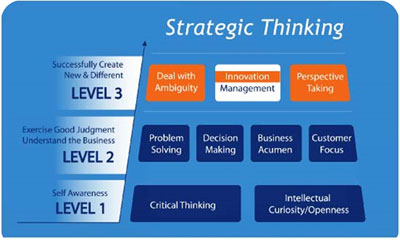What is Strategic Thinking and Why is It Important?
 When researching literature about strategic thinking, every author has his/her own definition for what constitutes strategic thinking. Indeed according to a report by the United States Army Research institute for the Behavior Sciences, the definition for strategic thinking has been changing through the decades to fit trends in business and management strategies. Modern literature offers a veritable smorgasbord of definitions. So how do people know if they are engaging in strategic thinking or not?
When researching literature about strategic thinking, every author has his/her own definition for what constitutes strategic thinking. Indeed according to a report by the United States Army Research institute for the Behavior Sciences, the definition for strategic thinking has been changing through the decades to fit trends in business and management strategies. Modern literature offers a veritable smorgasbord of definitions. So how do people know if they are engaging in strategic thinking or not?
An X-Ray of Strategic Thinking
The chart to the right, created by Dr. Judy Chartrand, and used with her permission, serves as an X-Ray, if you will, illustrating the foundation for strategic thinking, its uses, and finally implementing it for achieving successful outcomes. 
Moreover, one of the foundation pieces of strategic thinking, self-awareness, is also the foundation for leadership, and not just mundane leadership, but according to an article by Ron Mangus and Matt Kennedy, exceptional leadership. Let’s look at each of the three levels in Dr. Chartrand’s eye-opening chart and their importance.
Level 1: Self Awareness
Even though self-awareness is fast becoming the latest management buzz word, it is one of the most useful tools for humans to begin self-development, strategic thinking and the beginning of where we need to look when things are going wrong, e.g. “What do I need to improve for better success?” When we are whining or being a victim thinker, instead of asking, “When are they going to promote me?” The better question is, “What can I do to become indispensable, get noticed, and get promoted?” John G. Miller’s program on what he dubs “the QBQ” (the question behind the question) delves into asking the right questions for personal accountability or looking at how we can take control of our success and thinking.
Further, we cannot think critically if we have tunnel vision such as blaming others, having biases, or thinking that we are always correct. When we eliminate our biases, we then develop the ability to be open and curious.
In addition, The Penn State Resiliency Program lists self-awareness as one of its six skill sets. This skill is stated as “The ability to pay attention to your thoughts, emotions, behaviors, and physiological reactions.” To make better decisions and solve problems, it is essential to have the ability to not overreact to circumstances, business situations, and unexpected events. Overreacting often creates more problems by making current issues worse.
An article by Daniel Goleman suggests that self-awareness is the foundation for emotional intelligence. Those in leadership positions who lack emotional intelligence cannot be effective.
Level 2: Exercise Good Judgment, Understand the Business
Are you aware of your decision-making and problem-solving skills? Do you understand how you arrive at making a decision? Are you better at making large, important decisions, or are you better at the decisions that don’t matter much? Are you better at making decisions or solving problems for the outside world or are you better at making decisions and solving problems for yourself, or do you have a nice balance of being able to make decisions and solve problems in either world? Better decision making and problem solving are skills we can all learn and learn to do better. It takes practice. Part of that practice is to look at ourselves and determine if we are engaging in self-sabotage or failing to get out of our way for decision making and problem solving to take place. How does business acumen fit into all of this?
Business is all about solving problems. In earlier times, people needed shoes and the cobbler knew exactly how to solve that problem and began making shoes. People wanted to be able to see better in the evening and the lightbulb came into being along with power companies and retail outlets to purchase bulbs. Now people want their stuff fast and Amazon and drones are on the scene. But why do you need to have business acumen when the business you work with isn’t yours, or you don’t run a business? Regardless of your position in an organization, understanding at least the basics of business can help you become a problem solver or even a go to person for solving problems. This makes you indispensable and helps protect your career. On the other hand, decisions executives of an organization make hold life and death solutions to the survival of the business.
Level 3: Successfully Create New and Different
This level is about innovation, the ability to deal with and make decisions about the unknown and seeing the perspective of others. The ability to acknowledge, appreciate, and give credence to someone else’s perspective takes an elevated level of strategic thought.
Further, at this level, we encounter more complex subject matter, situations, and challenges. Simplistic thinking will not work at this level, period. At the third level, one must have the ability to identify the most important points in complex situations.
Ambiguity can pose a dilemma for many as humans like things in order 1, 2, 3 and in steps
A, B, C. Order is comforting, first you do this and then you do that. Today, we can have all the order we want, but it will change tomorrow. At no time in history has so much change taken place and hitting us at breakneck speed. Ambiguity may be just one of those adaptability challenges humans have been facing over eons. Learning what strategic thinking is and its importance from Dr. Chartrand’s chart will help the human adaptability element to succeed. Time will tell.
Thank you for reading this blog. For help on getting your team to think more strategically Let's get started
CEO, Strategic Planning,, High Performing Teams, Strategichinking